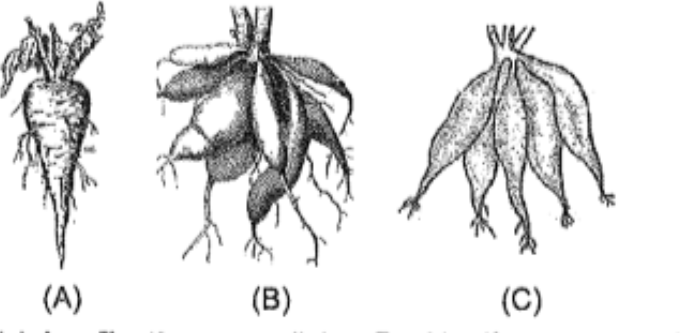Identify the given figures A, B, C, D and E.

A
B
C
D
E
(1)
Marginal
Axile
Free Central
Parietal
Basal
(2)
Marginal
Parietal
Free central
Axile
Basal
(3)
Marginal
Axile
Parietal
Free central
Basal
(4)
Marginal
Axile
Parietal
Basal
Free central

A
B
C
D
E
(1)
Marginal
Axile
Free Central
Parietal
Basal
(2)
Marginal
Parietal
Free central
Axile
Basal
(3)
Marginal
Axile
Parietal
Free central
Basal
(4)
Marginal
Axile
Parietal
Basal
Free central
Which of the following is correctly matched?
1. Monstera - Fibrous root
2. Dahlia - Fasciculated root
3. Azadirachta - Adventitious root
4. Basil - Prop roots
Plants with inferior ovary usually bear
(1) pseudocarps
(2) berries
(3) aggregate fruits
(4) seedless fruits
Plants having the above given floral diagram are
(1) leguminous
(2) dicots
(3) medicinal and perennial
(4) having pinnately compound leaves
Match Column - I With Column - II and choose the correct option from below.
|
Column - I |
|
||||
|
A. |
Marginal placentation |
(i) |
Sunflower |
||
|
B. |
Axile placentation |
(ii) |
Mustard |
||
|
C. |
Parietal placentation |
(iii) |
Lemon |
||
|
D. |
Basal placentation |
(iv) |
Pea |
||
(1) A - (iv), B - (iii), C - (ii), D- (i)
(2) A - (iv), B - (iii), C - (i), D- (ii)
(3) A - (iv), B - (i), C - (ii), D- (iii)
(4) A - (iii), B - (iv), C - (ii), D- (i)
Tetradynamous condition is found in
(1) Hibiscus rosa-sinesis
(2) Ocimum sanctum
(3) Helianthus annuus
(4) Brassica campestris
Select the mismatched pair out of the following.
(1) Rhizome - Dryopteris, Nelumbo nucifera
(2) Corm - Crocus sativus, Amorphophallus
(3) Sucker - Curcuma domestica, Zingiber officinale
(4) Tuber - Helianthus tuberosus, Solanum tuberosum
Which one of the following option is not correctly matched?
|
(1) cymose (2) Hypanthodium (3) Cyanthium (4) Verticillaster |
Acacia Banyan Euphorbia Calotropis |
Identify the type of root given in the figure, from the given options.
(1) A–Fusiform, radish; B–Napiform, turmeric; C–Tuberous, sweet potato
(2) A–Conical, turnip; B–Nodulated, sweet potato; C–Tuberous, Curcuma amada
(3) A–Conical, carrot; B–Tuberous, sweet potato; C–Fasciculated, Dahlia
(4) A–Napiform, carrot; B–Nodulated, Tamarind; C–Tuberous, turmeric
Inflorescence of which one of the following sets completely develop into composite fruits?
(1) Spike, corymb, hypanthodium
(2) Spike, female catkin, hypanthodium
(3) Umbel, catkin, spadix
(4) Female catkin, corymb, spike








